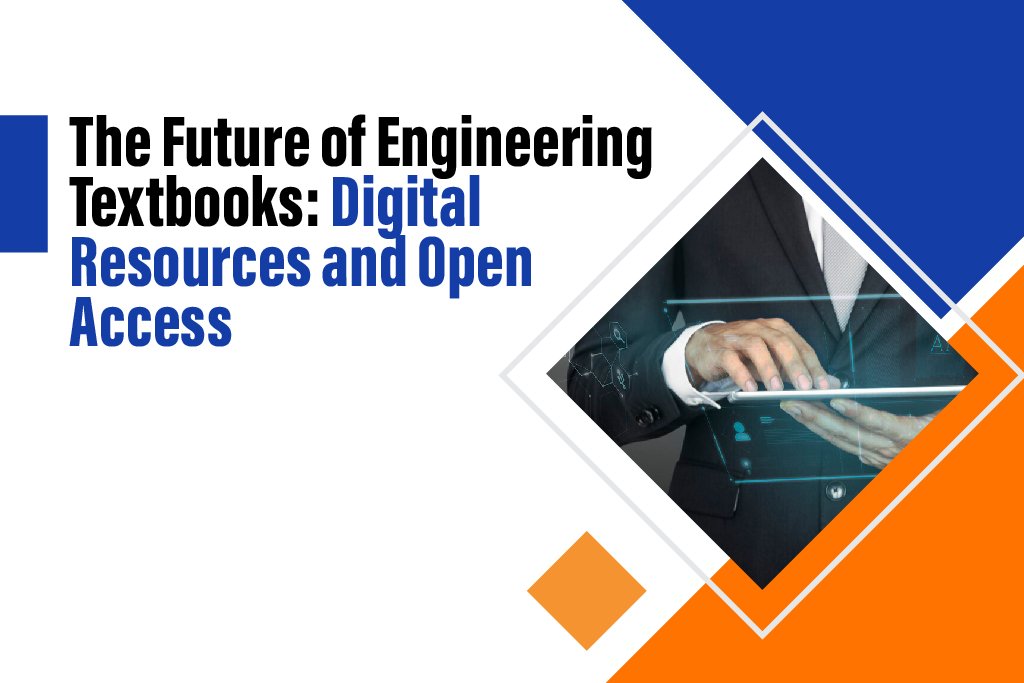
Introduction
Education in engineering is changing rapidly. From being the cornerstone of learning, textbooks have increasingly had to adapt to modern technologies. Change is much more than upgrading; it is an entirely different way students access and engage with knowledge.
In this article, we will discuss the future of engineering textbooks, two significant contributors being digital resources and the open access movement.
Traditional Textbooks in Engineering
Traditional engineering textbooks have long been the backbone of technical education. These texts offer structured knowledge, thorough diagrams, and problem-solving examples to help future engineers develop their skills.
Traditional textbooks have their own problems: They’re expensive, bulky, and quickly outdated in an industry that changes quickly; accessing them may also pose difficulties for those living in remote or underprivileged regions.
What Are Digital Resources and Their Advantages?
Digital resources encompass e- books, online platforms, and interactive tools designed to complement or replace traditional textbooks. Utilizing multimedia capabilities on the web for learning enhancement purposes.
Digital resources afford many advantages: They are cost-effective, accessible, and capable of evolving rapidly with development. Educational needs are success indicators for the educator and their students.
Enhanced Accessibility and Cost-Effectiveness
- Affordable Options for Students: The digital textbook is cheaper than the printed one, which will help save students money. Some of the resources are made available free of cost by open-access initiatives.
- Overcoming Geographical Barriers: Digital platforms enable students worldwide to access high-quality materials that span borders, creating equal educational access and closing any educational gaps that exist between institutions.
Interactivity and Multimedia Integration
- The Role of Interactive Simulations: Imagine learning complex engineering concepts in an interactive way through the use of digital tools and turning “theoretical” knowledge into one’s hands-on experience for deeper understanding.
- Video Tutorials and 3D Models: Video tutorials and 3D models enable students to better visualize and understand complex subjects, leading to improved comprehension and retention rates.
Real-Time Updates and Relevance
- Keeping Up with Industry Trends: Digital resources can be regularly updated, so students always learn relevant and up-to-date material.
- Customizable Learning Experiences: Many platforms allow students to customize their experience to address areas for improvement or to address interests that are directly related to them.
Open Access Movement in Education
- Understanding Open Access: Open Access means providing learners and educators access to educational material without restrictions or paywalls, increasing autonomy for both groups.
How It Benefits Engineering Students and Educators
Open access makes learning equal for all, but the professors get the privilege of spreading knowledge freely for a collaborative education atmosphere.
Free Access to Knowledge
- Open-Access Platforms for Engineering: MIT OpenCourseWare and Khan Academy are among the platforms that provide access to engineering education with the click of an internet button.
- Promoting Global Collaboration: Open access enables students and educators from around the world to collaborate and share knowledge, driving innovation.
Bridging the Gap in Underprivileged Regions
- Reducing Inequality in Education: The existence of digital and open-access resources helps to bridge the education gap since they can reach children in poor regions and, therefore, can acquire quality teaching.
- Case Studies of Success: Examples abound of students from remote regions excelling in engineering thanks to these resources, showing their transformative potential.
Challenges of Digital Resources and Open Access
Open-access digital resources have completely revamped learning and research opportunities in every area, presenting previously unfathomable access for scholars as well as instructors. Challenges remain, however, affecting effectiveness and access.
Digital Divide and Technological Barriers
One of the world’s greatest challenges today is digital inequality: A significant portion of its population still lacks access to devices or reliable internet connections that would allow them to take full advantage of digital resources; this inequality especially hurts students living in rural or underprivileged areas, further narrowing educational opportunities.
Furthermore, even when access is available, technical literacy barriers often prevent some from making full use of them – particularly those unfamiliar with using online platforms like social media.
Quality Control and Credibility Issues
Of course, the challenges open-access poses toward quality assurance ensure that a user may get misleading material or even dated material from a seemingly viable source, which negatively compromises quality learning outcomes and research outcome – emphasizing the need to bring sharper edges to curate and verify for open-access materials.
Copyright and Intellectual Property Concerns
Open access can blur the lines between intellectual property rights. Authors, creators, and publishers may encounter difficulty protecting their work against misuse or unintended distribution – an issue that complicates efforts to provide free access while at the same time giving creators adequate credit and compensation.
Over-reliance on Digital Platforms
Digital resources may seem convenient, but over-reliance may lead to decreased engagement with traditional learning methods – like physical textbooks and direct interactions – leading to decreased critical thinking ability and hands-on training, particularly for fields that necessitate practical application.
Data Privacy and Security Risks
Digitalization of learning materials poses privacy and security issues because user details are likely to be affected by breaches or misuse.
Conclusion
Despite these obstacles, digital resources and open access present transformative changes to education and provide students with more inclusive learning environments compared to what traditional systems give.
Meeting some of the core challenges-equalizing access, ensuring content quality, recognizing intellectual property rights, and protecting privacy-will thus help maximize the potential of these tools to bring about practical change in learning experiences. The future of education is bright, and with careful implementation, digital resources can foster a more accessible and enriched educational experience for all.
